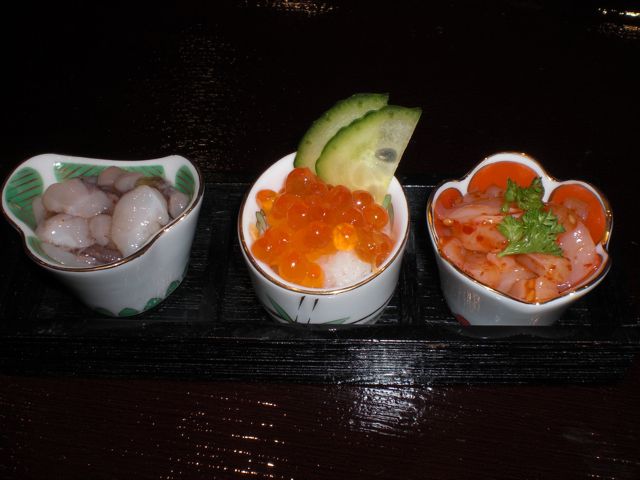A Japanese word "chinmi" 珍味 is often used to describe food items which are rare and/or limited to certain regions of Japan. You can assemble these rare tastes more easily nowadays by mail order and because of many special sales featuring these rare and regional food items (usually held in department stores in Japan). Even in the U.S., more and more of these "chinmi" items are becoming available, albeit much more limited compared to Japan. Tonight, we had an assortment of these rare tastes with sake.
Dried "Shishamo" fish 寒干しししゃも
This small fish called "Shishamo" ししゃも or 柳葉魚、Spirinchus lanceolatus, is harvested only on the southern pacific coast of Hokkaido. I grew up with this fish and they are very popular drinking snack items especially in Hokkaido. These are usually semi-dried and we get them frozen in the United States. My mother sent these to us. They were (supposedly) "fully dried" in the cold northwind of Hokkaido. They can be eaten as is but I grilled them briefly over the gas fire and served them with grated daikon 大根おろし and soy sauce. They are a bit chewier than semi-dried (which has to be more thoroughly grilled) but they are very flavorful. To my surprise, even my wife liked them.
Raw Octopus marinated in wasabi sauce たこぶっかけ (lt)、Salmon roe with grated daikon いくら甘酢大根おろし (ctr)、Raw Squid mariated in hot red peper sauce イカぶっかけ (rt)

My wife and I love "squid and guts" or squid "shiokara" いかの塩辛. This is definitely an acquired taste but most people who love sake will love this as well because both go together so well. Shiokara is made from fresh squid which is salted and slightly fermented with squid innards (mostly liver). The homemade variety made with a light amount of salt (this kind does not last long) is the best. Many commercial ones are too salty but more recently, we can get a less salty kind in a small plastic pouch in the frozen case of the Japanses grocery store. Last time we were in Hakodate we had commercial but local "shiokara" which was excellent. Another similar preparation is called "okizuke" 沖漬け. "oki" in Japanese means "far-away from the shore". Supposedly, fishermen start marinading the freshly caught squid (sometimes other fish or shell fish) while in their boat and by the time they come back to shore (overnight or one day), the dish is done. Once in a blue moon, Chef Kudo at
Tako Grill makes squid okizuke which is exquisite. Last time we were in Kanazawa, a small fluorescent squid called "hotaruika" 蛍イカ or firefly squid was in season. We really enjoyed "okizuke" of this small squid. Unfortunately, it is next to impossible to get a fresh squid suitable for making these dishes in the U.S. What we have here is the closest substitute.
In the above image, from left to right are raw octopus with wasabi sauce たこぶっかけ、salmon roe with grated daikon いくら大根おろし (grated diakon is seasoned with sweet vinegar which is only item I prepared)、and raw squid with hot sauce イカぶっかけ. These squid and octopus dishes are variations of "shiokara" and "okizuke" and are called "bukkake" ぶっかけ in which small pieces of raw octopus or squid are marinated in a spicy sauce. Here, the octopus is marinated in "wasabi" sauce and squid in red pepper sauce. Both come in a small plastic pouch and bought frozen. These are perfect accompaniment for sipping sake.
Cheese stuffed squid チーズいか
This is another item, my mother sent us. A Japanese word "Ikomi" 射込み means to "insert" or to "stuff" and this one is a type of "ikomi" squid. This is a commercial product in which a small squid was stuffed with cheese and cooked. This is eaten as is. Interesting combination of tastes. I served one for each of us but my wife went back and got another one. She must have liked it.
Smoked scallop 帆立ての薫製
This is a smoked whole scallop from Lake Saroma 佐呂間湖 in Hokkaido. To us, it is a bit too smoky and chewy.

No comments:
Post a Comment
When you post a comment on the post, it does not appear immediately pending moderation.